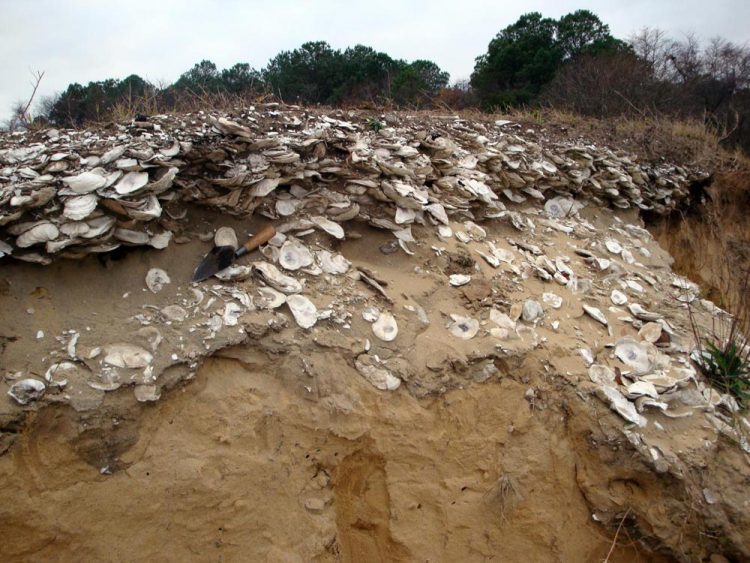Scientists find sustainable solutions for oysters in the future by looking into the past

A typical Native American oyster deposit, or midden, dating to about 1,000 years ago. Credit: Torben Rick
Despite providing food for humans for millennia, little is known about Chesapeake Bay oyster populations prior to the late 1800s. Using fossil, archaeological and modern biological data, the team of scientists was able to reconstruct changes in oyster size from four time frames: the Pleistocene (780,000-13,000 years ago), prehistoric Native American occupation (3,200-400 years ago), historic (400-50 years ago) and modern times (2000 to 2014).
They found that while oyster size fluctuated at certain points through time, it has generally decreased over time and the average size of modern oysters is significantly smaller than oysters from the 1800s and earlier.
“Our work demonstrates the importance of working across disciplines and using the past to help us understand and transcend modern environmental issues,” said Torben Rick, an anthropologist at the Smithsonian's National Museum of Natural History and lead author of the research.
“In this case, paleontology, archaeology, history and marine ecology all provided unique perspectives on the difficult puzzle of restoring Chesapeake oysters. Ultimately, they issue a challenge for us to make important and difficult decisions about how to restore and sustain our marine ecosystems and organisms.”
The team also found that Native Americans' method of selecting and hand-collecting oysters likely resulted in more consistent average sizes and fewer very small individual oysters. People were likely removing oysters from the reefs in a way that was biased toward medium-sized oysters without decreasing the average size of the oysters in the harvested populations.
With limited variability in oyster size and abundance, and no strong evidence for a size decline from 3,500 to 400 years ago, the Native American Chesapeake Bay oyster harvesting appears to have been largely sustainable, despite changing climatic conditions and sea-level rise. The teams point to four supporting factors:
- Water depth and technology restricted Native Americans' harvest primarily close to shore
- Oysters may have been harvested intensively at particular times of year and less so at others
- The density of the human population was drastically lower than today
- Broad-spectrum human diets that had a mix of marine and terrestrial resources
It is this sustainability of the Native American oyster fishery that can provide insight into the future restoration of oysters in the Chesapeake Bay and around the world. However, there are factors stacked against modern-day oysters that did not exist in the prehistoric Native American's time.
“Chesapeake Bay oysters now face challenges resulting from disease, poor water quality and over a century of overfishing, which not only removes oysters, but also destroys the reef habitat oysters depend on,” said Denise Breitburg, co-author and senior scientist at the Smithsonian Environmental Research Center. “These factors have led to the decline of oysters in Chesapeake Bay and are making restoration difficult. But large-scale efforts are underway to try to reverse the trend.”
The team's model of a sustainable prehistoric Native American harvest of oysters, primarily by hand from fringing reefs that left deeper-water reefs largely intact, supports recent plans for Chesapeake Bay oyster-restoration efforts.
They include reduction of modern harvest levels and creation of increased no-take zones that are conceptually similar to deep-water areas where harvest was unlikely in Native American fisheries. Current restoration plans also include enhancement of oyster density using hatchery seed and the addition of new hard substrate where needed. The team's Pleistocene data also provide a baseline against which the size distribution of oysters in no-take reserves could be evaluated.
While not solving all the challenges facing oysters in the Chesapeake, the team's research provides an example of an apparently sustainable millennial-scale fishery, elements of which may help inform restoration and harvest in today's ecosystem.
The archaeological component of this study was funded by the Smithsonian Institution and a Committee for Research and Exploration grant from the National Geographic Society.
Media Contact
All latest news from the category: Earth Sciences
Earth Sciences (also referred to as Geosciences), which deals with basic issues surrounding our planet, plays a vital role in the area of energy and raw materials supply.
Earth Sciences comprises subjects such as geology, geography, geological informatics, paleontology, mineralogy, petrography, crystallography, geophysics, geodesy, glaciology, cartography, photogrammetry, meteorology and seismology, early-warning systems, earthquake research and polar research.
Newest articles

NASA: Mystery of life’s handedness deepens
The mystery of why life uses molecules with specific orientations has deepened with a NASA-funded discovery that RNA — a key molecule thought to have potentially held the instructions for…

What are the effects of historic lithium mining on water quality?
Study reveals low levels of common contaminants but high levels of other elements in waters associated with an abandoned lithium mine. Lithium ore and mining waste from a historic lithium…

Quantum-inspired design boosts efficiency of heat-to-electricity conversion
Rice engineers take unconventional route to improving thermophotovoltaic systems. Researchers at Rice University have found a new way to improve a key element of thermophotovoltaic (TPV) systems, which convert heat…



